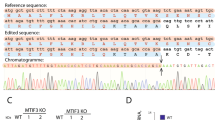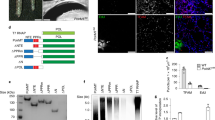Abstract
The NAM1/MTF2 gene was firstly isolated as a multicopy suppressor of mitochondrial splicing deficiencies and independently as a gene of which a thermosensitive allele affects mitochondrial transcription in organello. To determine which step in mitochondrial RNA metabolism is controlled in vivo by the NAM1 gene, mitochondrial transcripts of seven transcription units from strains carrying an inactive nam1::URA3 gene disruption in various mitochondrial genetic backgrounds were analysed by Northern blot hybridisations. In a strain carrying an intron-containing mitochondrial genome, the inactivation of the NAM1 gene led to a strong decrease in (or total absence of) the mosaic cytb and cox1 mRNAs and in transcripts of the atp6-rf3/ens2 genes, which are co-transcribed with cox1. Neither the accumulation of unspliced cytb or cox1 pre-mRNAs, nor that of excised circular intron molecules of ai1 or ai2 were observed, but the abundance of the bi1 and ai7 lariats was comparable to that observed in the wild-type strain, thus demonstrating that transcription of the cytb and cox1 genes does occur. In strains carrying the intron-less mitochondrial genome with or without the rf3/ens2 sequence, wild-type amounts of cytb and cox1 mRNAs were detected while the amount of the atp6 mRNA was always strongly decreased. The abundance of transcripts from five other genes was either slightly (21S rRNA) or not at all (cox2, cox3, atp9 and 15S rRNA) affected by the nam1 inactivation. This analysis leads to the conclusion that the NAM1 protein is not a general mitochondrial transcription factor, but rather is predominantly and selectively required for the processing and/or for the stability of cytb and cox1 intron-containing pre-mRNAs and of the atp6 transcripts. Since the original intronic mutations suppressed by the amplification of the NAM1 gene are situated in stem-loop rich structures, we propose that the NAM1 protein is a stem-loop RNA-binding protein that plays a role in determining RNA stability.
Similar content being viewed by others
References
Banroques J, Delahodde A, Jacq C (1986) A mitochondrial RNA maturase gene transferred to the yeast nucleus can control mitochondrial mRNA splicing. Cell 46:837–844
Ben Asher E, Groudinsky O, Dujardin G, Altamura N, Kermorgant M, Slonimski PP (1989) Novel class of nuclear genes involved in both mRNA splicing and protein synthesis in Saccharomyces cerevisiae mitochondria. Mol Gen Genet 215:517–528
Bousquet I, Dujardin G, Poyton RO, Slonimski PP (1990) Two group I mitochondrial introns in the cob-box and coxI genes require the same MRS1/PET157 nuclear gene product for splicing. Curr Genet 18:117–124
Carignani G, Groudinsky O, Frezza D, Schiavon E, Bergantino E, Slonimski PP (1983) An mRNA maturase is encoded by the first intron of the mitochondrial gene for the subunit 1 of cytochrome oxidase in S. cerevisiae. Cell 35:733–742
Claisse M, Aubert G, Clavilier L, Slonimski PP (1970) Méthode d'estimation de la concentration des cytochromes dans les cellules entières de levure. Eur J Biochem 15:430–438
Conrad-Webb H, Perlman PS, Zhu H, Butow RA (1990) The nuclear SUV3-1 mutation affects a variety of post-transcriptional processes in yeast mitochondria. Nucleic Acids Res 18:1369–1376
Costanzo MC, Fox TD (1990) Control of mitochondrial gene expression in Saccharomyces cerevisiae. Annu Rev Genet 24:91–113
Dieckmann CL, Mittelmeier TM (1987) Nuclearly-encoded CBP1 interacts with the 5′ end of mitochondrial cytochrome b pre-mRNA. Curr Genet 12:391–397
Dieckmann CL, Koerner TJ, Tzagoloff A (1984a) Assembly of the mitochondrial membrane system. CBP1, a yeast nuclear gene involved in 5′ end processing of cytochrome b pre-mRNA. J Biol Chem 259:4722–4731
Dieckmann CL, Homison G, Tzagoloff A (1984b) Assembly of the mitochondrial membrane system. Nucleotide sequence of a yeast nuclear gene (CBP1) involved in 5′ end processing of cytochrome b pre-mRNA. J Biol Chem 259:4732–4738
Dujardin G, Pajot P, Groudinsky O, Slonimski PP (1980) Long range control circuits within mitochondria and between nucleus and mitochondria. I. Methodology and phenomenology of suppressors. Mol Gen Genet 179:469–482
Gargouri AF (1989) Recherches sur les introns de l'ADN mitochondrial chez la levure Saccharomyces cerevisiae: mutations, suppressions et délétions génomiques d'introns. PhD Thesis, Université Pierre et Marie Curie, Paris 6, France
Grivell LA (1989) Nucleo-mitochondrial interactions in yeast mitochondrial biogenesis. Eur J Biochem 182:477–493
Groudinsky O, Altamura N, Ben Asher E, Bousquet I, Dujardin G, Ekwall K, Kermorgant M, Slonimski PP (1990) Nuclear genes interfering both with mitochondrial pre-mRNA splicing and other mitochondrial function. In: Lachowicz (ed) Genetics of respiratory enzymes in yeasts. Wroclaw University Press, Wroclaw, pp 246–251
Jacquier A, Dujon B (1983) The intron of the mitochondrial 21S rRNA gene: Distribution in different yeast species and sequence comparison between Kluyveromyces thermotolerans and Saccharomyces cerevisiae. Mol Gen Genet 192:487–499
Kotylak Z, Slonimski PP (1976) Joint control for cytochrome A and B by a unique mitochondrial DNA region comprising four genetic loci. In: Saccone C, Kroon AM (eds) The genetic function of mitochondrial DNA. Elsevier North-Holland, Amsterdam, pp 143–154
Labouesse M (1990) The yeast mitochondrial leucyl-tRNA synthetase is a splicing factor for the excision of several group I introns. Mol Gen Genet 224:209–221
Labouesse M, Slonimski PP (1983) Construction of novel cytochrome b genes in yeast mitochondria by subtraction or addition of introns. EMBO J 2:269–276
Labouesse M, Netter P, Schroeder R (1984) Molecular basis of the ‘box effect’. A maturase deficiency leading to the absence of splicing of two introns located in two split genes of yeast mitochondrial DNA. Eur J Biochem 144:85–93
Lisowsky T (1990) Molecular analysis of the mitochondrial transcription factor MTF2 of Saccharomyces cerevisiae. Mol Gen Genet 220:186–190
Lisowsky T, Michaelis G (1989) Mutations in the genes for mitochondrial RNA polymerase and a second mitochondrial transcription factor of Saccharomyces cerevisiae. Mol Gen Genet 219:125–128
Lisowsky T, Riemen G, Michaelis G (1990) Change of serine309 into proline causes temperature sensitivity of the nuclear NAM1/MTF2 gene product for yeast mitochondria. Nucleic Acids Res 18:7163
McGraw P, Tzagoloff A (1983) Assembly of the mitochondrial membrane system. Characterization of a yeast nuclear gene involved in the processing of the cytochrome b pre-mRNA. J Biol Chem 258:9459–9468
McLaren RS, Newbury SF, Dance GSC, Causton HC, Higgins CF (1991) mRNA degradation by processive 3′–5′ exoribonucleases in vitro and the implications for procaryotic mRNA decay in vivo. J Mol Biol 221:81–95
Myers AM, Pape LK, Tzagoloff A (1985) Mitochondrial protein synthesis required for maintenance of intact mitochondrial genomes in Saccharomyces cerevisiae. EMBO J 4:2087–2092
Nakagawa K, Morishima N, Shibata T (1991) A maturase-like subunit of the sequence-specific endonuclease Endo. SceI from yeast mitochondria. J Biol Chem 266:1977–1984
Nakagawa K, Morishima N, Shibata T (1992) An endonuclease with multiple cutting sites, Endo. SceI, initiates genetic recombination at its cutting site in yeast mitochondria. EMBO J 11:2707–2715
Osinga KA, De Vries E, Van Der Horst G, Tabak HF (1984) Processing of yeast mitochondrial messenger RNAs at a conserved dodecamer sequence. EMBO J 3:829–834
Séraphin B, Boulet A, Simon M, Faye G (1987a) Construction of a yeast strain devoid of mitochondrial introns and its use to screen nuclear genes involved in mitochondrial splicing. Proc Natl Acad Sci USA 84:6810–6814
Séraphin B, Simon M, Faye G (1987b) The mitochondrial reading frame RF3 is a functional gene in Saccharomyces uvarum. J Biol Chem 262:10146–10153
Séraphin B, Simon M, Faye G (1988) MSS18, a yeast nuclear gene involved in splicing of intron ai5β of the mitochondrial cox1 transcript. EMBO J 7:1455–1464
Simon M, Faye G (1984) Organization and processing of the mitochondrial oxi3/oli2 multigenic transcript in yeast. Mol Gen Genet 196:266–274
Somlo M, Clavilier L, Dujon B, Kermorgant M (1985) The phol mutation. A frameshift, and its compensation, producing altered forms of physiologically efficient ATPase in yeast mitochondria. Eur J Biochem 150:89–94
Tian G-L (1993) Recherches sur la structure et l'organisation du génome mitochondrial de la levure Saccharomyces douglasii et d'un génome mitochondrial chimérique Saccharomyces douglasii et Saccharomyces cerevisiae. Thesis, Université Pierre et Marie Curie, Paris 6, France
Tian G-L, Macadre C, Kruszewska A, Szczesniak B, Ragnini A, Grisanti P, Rinaldi T, Palleschi C, Frontali L, Slonimski PP, Lazowska J (1991a) Incipient mitochondrial evolution in yeasts. I. The physical map and gene order of Saccharomyces douglasii mitochondrial DNA discloses a translocation of a segment of 15,000 base-pairs and the presence of new introns in comparison with Saccharomyces cerevisiae. J Mol Biol 218:735–746
Tian G-L, Michel F, Macadre C, Slonimski PP, Lazowska J (1991b) Incipient mitochondrial evolution in yeasts. II. The complete sequence of the gene coding for cytochrome b in Saccharomyces cerevisiae reveals the presence of both new and conserved introns and discloses major differences in the fixation of mutations in evolution. J Mol Biol 218:747–760
Tzagoloff A, Dieckmann CL (1990) PET genes of Saccharomyces cerevisiae. Microbiol Rev 54:211–225
Valencik M, McEwen J (1991) Genetic evidence that different functional domains of the PET54 gene product facilitate expression of the mitochondrial genes cox1 and cox3 in Saccharomyces cerevisiae. Mol Cell Biol 11:2399–2405
Weiller GF, Bruckner H, Kim SH, Pratje E, Schweyen RJ (1991) A GC cluster repeat is a hotspot for mit− macro-deletions in yeast mitochondrial DNA. Mol Gen Genet 226:233–240
Wiesenberger G, Waldherr M, Schweyen RJ (1992) The nuclear gene MRS2 is essential for the excision of group II introns from yeast mitochondrial transcripts in vivo. J Biol Chem 267:6963–6969
Author information
Authors and Affiliations
Additional information
Communicated by W Gajewski
Rights and permissions
About this article
Cite this article
Groudinsky, O., Bousquet, I., Wallis, M.G. et al. The NAM1/MTF2 nuclear gene product is selectively required for the stability and/or processing of mitochondrial transcripts of the atp6 and of the mosaic, cox1 and cytb genes in Saccharomyces cerevisiae . Molec. Gen. Genet. 240, 419–427 (1993). https://doi.org/10.1007/BF00280396
Received:
Accepted:
Issue Date:
DOI: https://doi.org/10.1007/BF00280396




